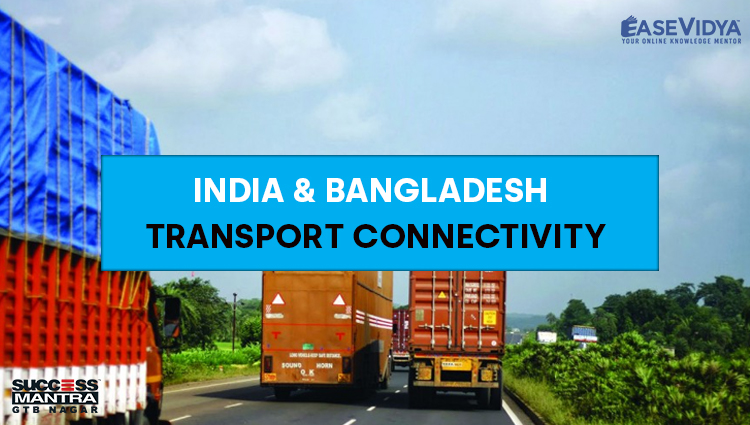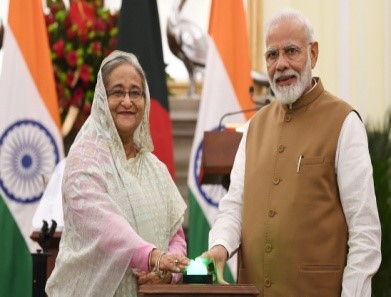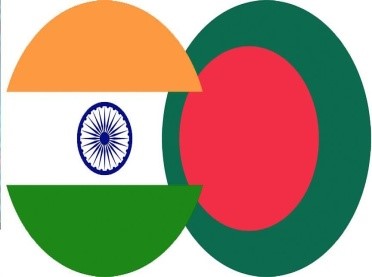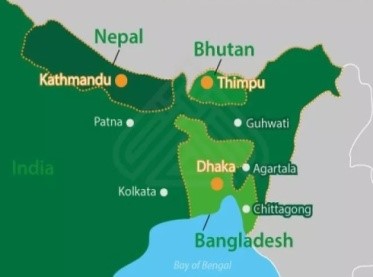
INDIA AND BANGLADESH TRANSPORT CONNECTIVITY
INDIA & BANGLADESH TRANSPORT CONNECTIVITY

Recently, a World Bank report named “Connecting to Thrive: Challenges and Opportunities of Transport Integration in Eastern South Asia” stated that seamless transport connectivity between India and Bangladesh has the potential to increase national income by as much as 17% in Bangladesh and 8% in India. The report analyzes the Bangladesh-Bhutan-India-Nepal (BBIN) Motor Vehicles Agreement (MVA).
KEY HIGHLIGHTS OF THE MATTER

Trade: Bilateral trade accounts for only about 10% of Bangladesh’s trade and a mere 1% of India’s trade. In East Asian and Sub-Saharan African economies, intraregional trade accounts for 50% and 22% of total trade, respectively. High tariffs, para-tariffs, and nontariff barriers also serve as major trade barriers. Simple average tariffs in Bangladesh and India are more than twice the world average.
Difficulty in Crossing Border: Weak transport integration makes the border between Bangladesh and India thick. Crossing the India–Bangladesh border at Petrapole–Benapole, the most important border post between the two countries, takes several days. In contrast, the time to cross borders handling similar volumes of traffic in other regions of the world, including East Africa, is less than six hours.
Isolated North-East: Indian trucks are not allowed to transit through Bangladesh. As a result, the northeast of India is particularly isolated with the rest of the country and connected only through the 27-km-wide Siliguri corridor, also called the “chicken’s neck”. This leads to long and costly routes.
BENEFITS OF BETTER CONNECTIVITY

Increased Real Income: All districts in Bangladesh would benefit from integration, with the eastern districts enjoying larger gains in real income. States bordering Bangladesh such as Assam, Meghalaya, Mizoram, and Tripura in the northeast, and West Bengal on the west, and states further away from Bangladesh such as Uttar Pradesh and Maharashtra would also gain huge economic benefits from seamless connectivity.
Increased Exports: Will yield a 297% increase in Bangladesh’s exports to India and a 172% increase in India’s exports to Bangladesh. Geographically, Bangladesh’s location makes it a strategic gateway to India, Nepal, Bhutan, and other East Asian countries. Bangladesh can also become an economic powerhouse by improving regional trade, transit and logistics networks.
Improving Regional Connectivity: Expand the effective capacity of core transport and logistics infrastructure along regional corridors. Ensure competition in transport service markets Deploy modern information technology infrastructure at land ports and seaports. Develop off-border custom clearance facilities in Bangladesh and India.
Integration of Local Communities: Connecting local markets to regional corridors. Removing logistics bottlenecks in export-oriented value chains. Improving women’s participation in export-oriented agricultural value chains at the macro, community, and household levels.
BANGLADESH-BHUTAN-INDIA-NEPAL (BBIN)
BBIN: The Bangladesh, Bhutan, India, Nepal (BBIN) Initiative is a sub-regional architecture of countries in Eastern South Asia, a sub-region of South Asia. The group meets through the official representation of member states to formulate, implement and review quadrilateral agreements across areas such as water resources management, connectivity of power, transport, and infrastructure.
Motor Vehicle Agreement (MVA): It was signed on 15th June 2015 in Thimphu, Bhutan. It seeks to facilitate the unrestricted cross-border movement of cargo, passenger, and personal vehicles between BBIN countries. As per the agreement, member countries would allow vehicles registered in the other countries to enter their territory under certain terms and conditions. Customs and tariffs will be decided by the respective countries and these would be finalised at bilateral and trilateral forums. Implementation of the MVA has been delayed as the countries work to clarify some of the provisions that are supposed to be elaborated in protocols. The objective is to provide seamless people-to-people contact and enhance economic interaction by facilitating cross border movement of people and goods.
RELATIONSHIP BETWEEN INDIA & BANGLADESH
Bilateral Ties: The year 2021 marks the 50th year of the establishment of bilateral ties between India and Bangladesh. The Prime Minister of India will also be visiting the country for the centenary celebrations of Father of the Nation, Mujibur Rehman. The Bangladesh Army contingent had also participated in the Republic Day 2021. Moreover, India's commitment to remove non-tariff barriers has reset the positive course of bilateral ties.
Swarnim Vijay Varsh: As part of the 'Swarnim Vijay Varsh' (50th year of independence), Indian Naval Ships are scheduled to make their first visit to the Mongla port in Bangladesh. The indigenously developed Sumedha (Offshore Patrol vessel) and Kulish (guided missile corvette) will be heading to the port to commemorate the day.
Other Major Progress: A trial run of container cargo has been conducted through Bangladesh’s Chattogram (Chittagong) port to Agartala. Two new protocol routes to inland waterways have been added connecting Tripura with the national waterways through Bangladesh.
The Maitri Setu: The PM of India will inaugurate ‘Maitri Setu’ bridge built over the Feni river which flows between the Indian boundary in Tripura and Bangladesh. The name ‘Maitri Setu’ symbolizes growing bilateral relations and friendly ties between India and Bangladesh.
CONCLUSION
India has a stake in Bangladesh not only for the security of its eastern borders but also for other strategic advantages. Therefore, it cannot afford to let go of the recently achieved opportunity to break away from the past trajectory and establish new contours of engagement with Bangladesh. The government needs to be constantly mindful of the significance of a good relationship with Bangladesh. Else, it may be all too easy to lose the moment and pave the way for China’s inroads in the region.
QUESTIONS (1-5)
Q.1 Recently, World Bank released report named “Connecting to Thrive: Challenges and Opportunities of Transport Integration in Eastern South Asia” analyzes which of the following?
- Bangladesh-Sri Lanka-India-Nepal Motor Vehicles Agreement (MVA).
- Bangladesh-Myanmar-India-Nepal Motor Vehicles Agreement (MVA).
- Bangladesh-Bhutan-India-Nepal (BBIN) Motor Vehicles Agreement (MVA): ANSWER
- None of the above
Q.2 Consider the following statements & state which of the following is correct in the reference to the above-mentioned passage?
- The year 2020 marks the 50th year of the establishment of bilateral ties between India and Bangladesh: ANSWER
- The Prime Minister of India will be visiting Bangladesh for the centenary celebrations of Father of the Nation, Mujibur Rehman.
- Prime Minister Narendra Modi inaugurated the 1.9-km-long ‘Mitra Setu’ or the India-Bangladesh Friendship Bridge.
- None of the following
Q.3 Which of the following is observed in Bangladesh to commemorate the victory of the Armed forces in the 1971 Indo-Pakistani War?
- Bangladesh Raising Day
- Swarnim Vijay Varsh: ANSWER
- Year of Victory
- Vijay Diwas
Q.4 Which of the following statements is incorrect in the context of Motor Vehicles Agreement (MVA) of BBIN?
- It was signed in Dhaka, Bangladesh & seeks to facilitate the unrestricted cross-border movement of cargo, passenger, and personal vehicles between BBIN countries.
- The member countries would allow vehicles registered in the other countries to enter their territory under certain terms and conditions under the Agreement
- Only I follows: ANSWER
- Only II follows
- Both I & II is correct
- None is correct
Q.5 Which of the following country's military contingent have joined the India's Republic Day Parade before the Bangladeshi Army?
- USA & Russia
- France & UAE: ANSWER
- Saudi Arabia & UAE
- None of the above













0 Comment